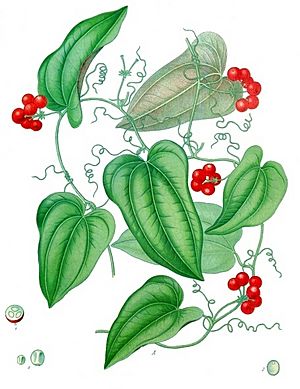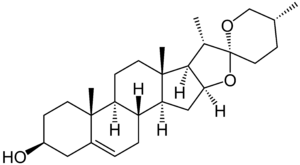Smilax facts for kids
Quick facts for kids Smilax |
|
|---|---|
 |
|
| Mediterranean smilax (S. aspera) in fruit | |
| Scientific classification |
|
| Kingdom: | Plantae |
| Clade: | Tracheophytes |
| Clade: | Angiosperms |
| Clade: | Monocots |
| Order: | Liliales |
| Family: | Smilacaceae |
| Genus: | Smilax L. |
| Type species | |
| Smilax aspera L.
|
|
| Species | |
|
About 300–350 (see list) |
|
| Synonyms | |
|
|
Smilax is a group of about 300 to 350 different species of climbing plants. You can find them all over the world, especially in warm, wet areas called tropics and subtropical regions. For example, China has about 80 types of Smilax, and 39 of these are found nowhere else. North America, north of Mexico, has 20 different kinds.
These plants are often woody and have thorns. They belong to the monocotyledon plant family called Smilacaceae. Some common names for Smilax plants are catbriers, greenbriers, prickly-ivys, and smilaxes. The name Sarsaparilla is used for a specific type from Jamaica, called S. ornata. It's also a general name for many American species. Some types of Smilax that are not woody, like the smooth herbaceous greenbrier (S. herbacea), are sometimes called carrion flowers.
The scientific name Smilax comes from an old Greek myth. It's a story about a man named Crocus and a nymph named Smilax. In the myth, their love story ends sadly. Crocus turns into a flower, and Smilax becomes a thorny vine.
Contents
What Smilax Plants Look Like
If left to grow on their own, Smilax plants form thick, dense bushes. These bushes can be very hard to get through. They can also climb over trees and other plants, reaching up to 10 meters (about 33 feet) high. Their hooked thorns help them grab onto branches and climb.
Some Smilax species lose their leaves in the fall (these are called deciduous plants). Others keep their leaves all year round (these are evergreen plants). The leaves are shaped like hearts and can be anywhere from 4 to 30 centimeters (about 1.5 to 12 inches) long, depending on the species.
How Smilax Plants Reproduce
Smilax plants are dioecious. This means that each plant has either male flowers or female flowers, but not both. For a plant to make fruit, there needs to be a male plant and a female plant nearby. However, only about one out of three groups of Smilax plants have both male and female plants.
The plants bloom in May and June, showing white or green flowers in clusters. If the flowers are pollinated, the plant will grow a bright red to blue-black round berry. These berries are about 5 to 10 millimeters (0.2 to 0.4 inches) wide. They become ripe in the fall.
Where Smilax Plants Grow
Smilax plants grow all over the world in tropical areas. They also spread into the cooler, temperate zones next to these areas, both north and south. For example, there are 29 different species found in Central America and the Caribbean islands.
Smilax in Nature
The berries of Smilax plants have a rubbery feel and a large, round seed inside. These fruits stay on the plant through the winter. This makes them an important food source for birds and other animals when other foods are scarce. When animals eat the berries, the seeds pass through their bodies unharmed. This helps spread the seeds to new places.
Smilax plants are very tough. They can grow back from their underground stems, called rhizomes, even after being cut down or burned by fires. Because birds and other small animals spread their seeds widely, these plants can be very hard to remove once they start growing. Smilax grows best in moist forests where the soil is slightly acidic. The seeds are more likely to sprout after they have been exposed to freezing temperatures.

Besides providing food, greenbrier plants also offer shelter for many animals. Their thorny thickets create safe hiding spots. Small animals can hide from larger predators who cannot get through the prickly tangle. Deer and other plant-eating mammals, called herbivores, eat the leaves. Some invertebrates, like Lepidoptera (which include butterflies and moths), also eat the leaves and drink nectar from the flowers. Even some beetles are known to eat Smilax leaves.
Many butterfly and moth caterpillars like to eat Smilax plants. Some examples include:
- Faunis butterflies
- Kaniska canace, also known as the blue admiral butterfly (which eats China smilax, S. china)
- Phalanta phalantha, known as the common leopard butterfly (which eats S. tetragona)
Uses of Smilax

The roots of some Smilax species are used to make drinks. The most famous is Jamaican sarsaparilla (S. ornata), which is used in sarsaparilla drinks and other root beers. It's also in herbal drinks like Baba Roots from Jamaica. Two other species, S. domingensis and S. havanensis, are used to make a traditional Cuban soda-like drink called pru.
The roots can also be added to soups or stews. The young shoots of the plant can be eaten raw or cooked. People say they taste like asparagus. The berries can also be eaten, both raw and cooked. In the Beijing region of China, there's a traditional snack called fúlíng jiābǐng. It's a stuffed pancake that uses Smilax.
S. glabra is an important plant in Chinese herbology, which is a type of traditional medicine. It's also a key ingredient in a Chinese medical dessert called guīlínggāo. This plant helps the dessert set into a jelly.
In Latin America, the powdered roots of Jamaican sarsaparilla are used as a traditional medicine for gout. An old book from 1887, Köhler's Medicinal Plants, talks about the American sarsaparilla (S. aristolochiifolia). Even earlier, around 1569, a scholar from Iran named Imad al-Din Mahmud ibn Mas‘ud Shirazi wrote in detail about the medical uses of chinaroot.
Some chemicals found in Smilax plants include diosgenin, parillin, sarsapic acid, sarsapogenin, and sarsaponin.
Because their flowers are full of nectar, species like S. medica and S. officinalis are good honey plants. This means they help bees make honey.
Sometimes, a plant called Asparagus asparagoides is mistakenly called "smilax" when used for floral decorations.
Gallery
-
S. melastomifolia, called hoi kuahiwi on Hawaiʻi
See also
 In Spanish: Smilax para niños
In Spanish: Smilax para niños








